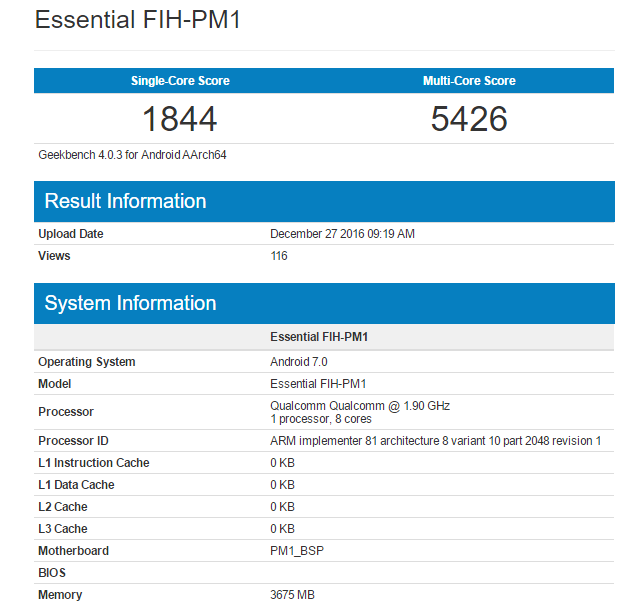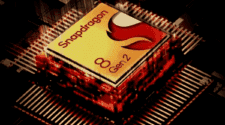New Snapdragon 835 is the most expected SoC of next year. Many people wait for new phones using this processor, so Qualcomm has announced they will give more information about it on CES 2017. As for now GeekBench leaked score showing performance of it.
According to GeekBench 4.0 there is a device called Essential FIH-PM1 that appear to be engineering testing phone. In this phone there is processor with ID ARM implementer 81, which belongs to Qualcomm Kryo architecture. Many roumours say it is Snapdragon 835 which appear to be Octa core 1.9GHz. In this phone there is also 4GB RAM and Android 7.0.

Gizchina News of the week
As we can see on screen above, phone have 1844 points in single core test and 5426 points in multi-core test. It isn’t too impressive, because Snapdragon 821 in OnePlus 3T have 1924 points in single core and 4969 points in multi-core. What is more Kirin 960 in Huawei Mate 9 Pro has 1949 points in single core and 6439 points in multi-core. I think it’s because SoC in Essential phone doesn’t have full clock frequency.
What is more, as we know from the previous news, Snapdragon 835 is built in 10 nm, equipped with Snapdragon X16 LE Modem, and it supports Quick Charge 4.0. For more details wait to CES2017 which will take place in a week.






Trash?
Why?
Probably because it won’t be inside an elephone device, so he’s paid to say so
All of this hardware isn’t making up for the lack of optimization. Apple is doing way more with less.
Most technical people know that android so far are very lack of optimization, they just too busy keep upgrading the hardware every 6 months.
But problem is Apple product is VERY VERY VERY outrageously expensive so yeah i still prefer android with more powerful hardware and much much cheaper price ( i will buy those mainstream model from reputable china brand like xiaomi, LeEco, OnePlus).
So yeah for now we cannot have the best of both world, Cheap, good hardwares, and optimized software.
How about you two clowns first read something before posting.
Firth of all the Android mostly use Java for its uper layer & apps, it’s easier to distribute, program & menage but even with top AOT (ART) compiler its still 2x slower than native compiled C++ for instance.
iOS uses C++ native compiled VLLM code for apps and cetera.
When both of them use native compiled libs depending of their MP support Android flagship’s take a lead regarding performance in those who support good multi processor simultaneous execution (like 7zipp) but their is very little of those. Android is faster in task switching especially when app is kept in memory (Linux legacy) which isn’t case in iOS.
By the way rather good written and optimized code is a more of a science fiction than anything else this day’s, there are some high optimized specialised libs for math mostly but their are not used widely & certainly not on typical iOS and Android junk of apps, same goes for compiler flags and libs.
Is it possible to bring & use native apps to Android?
Yes in many ways but up to date very little is done about it.
One of the ways is using QT & KDE community did bring cuple of serious apps that use it for now (& again even those use only 32 bit [ARM v7] libs for now).
Example:
https://play.google.com/store/apps/details?id=org.kde.kalgebramobile
Is it possible to tune compiler flags without to much effort & self experimenting?
I would say yes along with much other things.
http://cknowledge.org/repo/web.php?action=index&module_uoa=wfe&native_action=show&native_module_uoa=program.optimization
Why isn’t widely spreaded?
Well most most app developers are lazy, not skilled enough & far from good programmer’s so they prefer to use spreaded visual adjusted programing frameworks like Android studio and those are naturally slow.
Google wanted a diversity & fast spread of apps ecosystem that’s why they did go with Java & they got it but now when Android should become more serious we have a problem regarding it but solvable one.
Will & when will things change for better, guess I don’t really know but we will see.
Thank you for breaking it down for them.
I don’t really like that much they’ve gone back to octacore architecture, I’d rather a kryo version of sd801… Let’s wait and see…
You won’t see it with Kryo it’s not power efficient for something like that. Me by with reference A73 cores but I don’t have high hopes even regarding something like that.
Don’t know much about the actual architecture, so I’ll trust what you say… And it’s a shame, I would rather see a device lasting for several hours instead of breaking the 200k score on antutu… I’ll wait for a 2017 version of sd625, that’s really the soc of the year imho
Well judging by the S820 & comparing it to let’s say S652 you see how much Kryo is really inefficient even it has the 14nm FinFET lithography against 28nm HPM that roughly almost cut in half power consumption per gate.
Think S660 culd be nice but we will have to wait & see even it still isn’t what I hoped for. Not particularly impressed by S625 would rather have bigger cores with more restrictive frequency jumps delivering more performance in the end.
Trash🚯
Why?
Probably because it won’t be inside an elephone device, so he’s paid to say so
All of this hardware isn’t making up for the lack of optimization. Apple is doing way more with less.
Most technical people know that android so far are very lack of optimization, they just too busy keep upgrading the hardware every 6 months.
But problem is Apple product is VERY VERY VERY outrageously expensive so yeah i still prefer android with more powerful hardware and much much cheaper price ( i will buy those mainstream model from reputable china brand like xiaomi, LeEco, OnePlus).
So yeah for now we cannot have the best of both world, Cheap, good hardwares, and optimized software.
How about you two clowns first read something before posting.
Firth of all the Android mostly use Java for its uper layer & apps, it’s easier to distribute, program & menage but even with top AOT (ART) compiler its still 2x slower than native compiled C++ for instance.
iOS uses C++ native compiled VLLM code for apps and cetera.
When both of them use native compiled libs depending of their MP support Android flagship’s take a lead regarding performance in those who support good multi processor simultaneous execution (like 7zipp) but their is very little of those. Android is faster in task switching especially when app is kept in memory (Linux legacy) which isn’t case in iOS.
By the way rather good written and optimized code is a more of a science fiction than anything else this day’s, there are some high optimized specialised libs for math mostly but their are not used widely & certainly not on typical iOS and Android junk of apps, same goes for compiler flags and libs.
Is it possible to bring & use native apps to Android?
Yes in many ways but up to date very little is done about it.
One of the ways is using QT & KDE community did bring cuple of serious apps that use it for now (& again even those use only 32 bit [ARM v7] libs for now).
Example:
https://play.google.com/store/apps/details?id=org.kde.kalgebramobile
Is it possible to tune compiler flags without to much effort & self experimenting?
I would say yes along with much other things.
http://cknowledge.org/repo/web.php?action=index&module_uoa=wfe&native_action=show&native_module_uoa=program.optimization
Why isn’t widely spreaded?
Well most app developers are lazy, not skilled enough & far from good programmer’s so they prefer to use spreaded visual adjusted programing frameworks like Android studio and those are naturally slow.
Google wanted a diversity & fast spread of apps ecosystem that’s why they did go with Java & they got it but now when Android should become more serious we have a problem regarding it but solvable one.
Will & when will things change for better, guess I don’t really know but we will see.
Thank you for breaking it down for them.
I don’t really like that much they’ve gone back to octacore architecture, I’d rather a kryo version of sd801… Let’s wait and see…
You won’t see it with Kryo it’s not power efficient for something like that. Me by with reference A73 cores but I don’t have high hopes even regarding something like that.
Don’t know much about the actual architecture, so I’ll trust what you say… And it’s a shame, I would rather see a device lasting for several hours instead of breaking the 200k score on antutu… I’ll wait for a 2017 version of sd625, that’s really the soc of the year imho
Well judging by the S820 & comparing it to let’s say S652 you see how much Kryo is really inefficient even it has the 14nm FinFET lithography against 28nm HPM that roughly almost cut in half power consumption per gate.
Think S660 culd be nice but we will have to wait & see even it still isn’t what I hoped for. Not particularly impressed by S625 would rather have bigger cores with more restrictive frequency jumps delivering more performance in the end.
Lol. Is this a joke? Cant be real. Kirin 960 kills it at 16nm. This is 10nm. Even an SD821 on 10nm would probably perform better than this on both single n multicore.
This cant be real.
It could possibly be the s660. The clock speed is pretty low.
Yep. It has to be SD660.
Relax. It’s clocked lower than it supposed to. The S835 was built for 2.7-3.0 ghz stable clock rate
Nope. Geekbench always shows the clock speed of the slowest core of im not wrong.
Did anyone even consider how this actually culd be a S660 & not a S835?
Agreed. ?
Lol. Is this a joke? Cant be real. Kirin 960 kills it at 16nm. This is 10nm. Even an SD821 on 10nm would probably perform better than this on both single n multicore.
This cant be real.
It could possibly be the s660. The clock speed is pretty low.
Relax. It’s clocked lower than it supposed to. The S835 was built for 2.7-3.0 ghz stable clock rate
Nope. Geekbench always shows the clock speed of the slowest core of im not wrong.
Yep. It has to be SD660.
Did anyone even consider how this actually culd be a S660 & not a S835?
Agreed. 👍
Look at the individual tests (especially html5dom parse).
Either Qualcomm made some major arch changes (with some regressions) or is a different arch.
Given the freq I think we can say with some confidence that it’s the 653 w/a73.
Sorry, that stood be the 660.
Look at the individual tests (especially html5dom parse).
Either Qualcomm made some major arch changes (with some regressions) or is a different arch.
Given the freq I think we can say with some confidence that it’s the 653 w/a73.
Sorry, that stood be the 660.